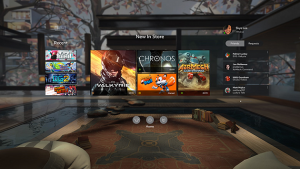Despite now being available for consumer audiences, virtual reality (VR) still has a lot of hurdles to overcome in order to reach mainstream adoption. It’s long been said that the greatest enemy of VR is ‘bad’ VR, and so quality control is essential. But looking at the VR videogame line-up at present, it’s not as easy to appreciate as one might’ve been expecting six month ago.
The term ‘quality control’ sadly doesn’t refer to how much fun or how engaging an experience will be, but rather how it performs with respect to issues such as simulator sickness. Avoiding making audiences feel ill while utilising VR is arguably the most critical issue to the medium at present, and some developers are still yet to find ways to avoid doing so. In the meantime however, the two leading head-mounted displays (HMDs) have a war waging in terms of the actual enjoyment that can come from their experiences.
At the time of writing the HTC Vive offers a wide variety of software, with no less than 128 titles claiming to support the device in one way or another. These include full releases, Steam Early Access titles, videogames and experiences. The Oculus Rift however, has less than 60 videogames, apps, 360 degree video productions and ‘concepts’ listed on the Oculus Home store.
There’s no denying right now that the HTC Vive is the developer’s HMD of choice. Valve and HTC has ensured that access to hardware is easy, that the development process is supported and that bringing software to market is no more complicated than any other videogame launch on Steam. However, this has left the platform widely open to abusers; developers of software who are not out to aid the progression of VR but rather to spin a quick buck.
Oculus VR’s tight reigns have lead to some developers being dismayed by the Oculus Home storefront; the lower visibility and currently minuscule audience not helping matters. However, aside from a few unfortunate missteps the average quality of the handful of launch titles was far above that of the HTC Vive when it comes to entertainment values. The Oculus Rift launch line-up was labelled as being ‘safe’ by many – with few experiences pushing the extreme potential of VR – but in that same regard early adopters will likely know what to expect and be comfortable with that which the HMD can offer.

It’s a tight balancing act between delivering quality software and ensuring that your audience is as widely catered for as possible, and both Valve/HTC and Oculus VR have already drawn lines in the sand as to what that means. The last 12 months were about the race to market and pursuing those early adopters, while the next year will be about supporting those who have dived in early on. Arguably, it’s no longer about which HMD will fulfil your wishes, but which storefront is going to appease your needs for VR entertainment.















